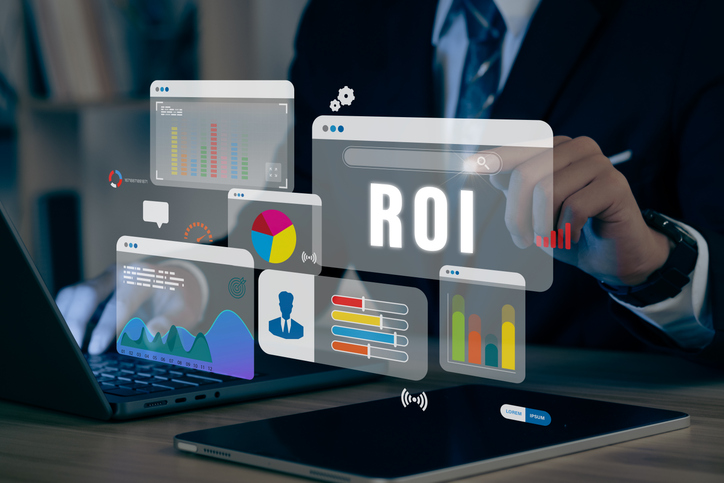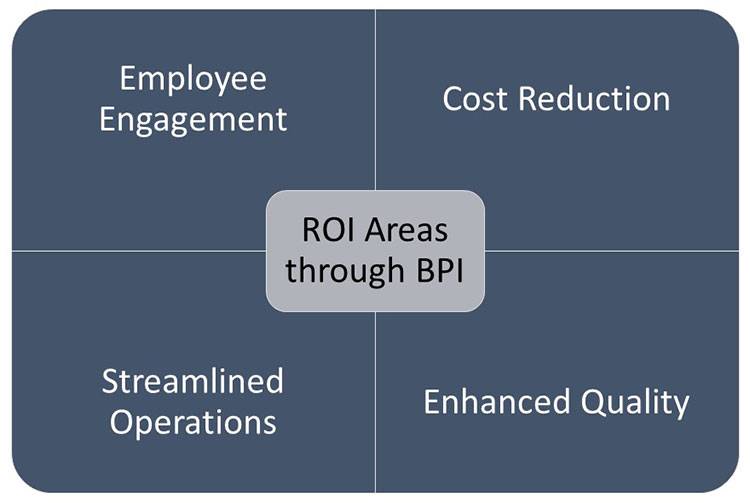Improve ROI from Your ERP
An enterprise resource planning (ERP) system takes significant organizational resources, and therefore being able to get a return on investment is crucial. However, assessing and improving the ROI from ERP implementation is a process that requires a strategic approach. An ERP system helps your organization to integrate all your core business processes—such as accounting, finance, inventory management and human resources—onto a single platform.
This article will cover the following:
- The major areas to consider when measuring and anticipating ROI after ERP software implementation
- Tips to improve ROI from ERP systems

Areas to Consider When Measuring ROI After ERP Implementation
When your ERP system goes live, monitoring and measuring the ROI is essential as this helps ensure that the benefits you get outweigh the system’s operational costs. The following are the five major areas that you can focus on when measuring and anticipating ROI after an ERP implementation.
1. Productivity
Improving productivity is one of the major reasons organizations invest in ERP systems. An ERP system helps your organization increase efficiency and productivity by streamlining processes, automating repetitive and manual tasks and eliminating data silos. Therefore, it’s crucial to measure productivity gains before and after implementation in areas such as order fulfillment and employee productivity when determining the ROI of an ERP.
2. Operational Costs
As modern ERP systems can help automate manual tasks and streamline your business processes, there are several areas where your organization may see cost savings after an ERP implementation due to increased operational efficiency. IT costs, labor, inventory, and other expenses you’ve identified pre-implementation could each be evaluated.
IT costs—such as personnel, training, software, hardware, system replacements and related services—are an area to consider when determining your ERP ROI. Compare the IT costs of the new system with the costs of your previous system when assessing and measuring the ERP ROI. Then, determine the savings your organization has been able to achieve through reduced maintenance costs, support contracts and upgrade cost reduction.
Labor costs may be impacted by your new system by freeing up personnel to focus on higher value activities and eliminating time-consuming manual tasks. Optimizing shop floor processes and production schedules also provides savings by reducing bottlenecks and providing real-time insights to allocate time and resources.
Savings can also extend to the warehouse, optimizing inventory management by reducing carrying costs, over-purchasing and timing purchases to demand. You may also evaluate savings through better warehouse data, tracking inventory movements to reduce waste and loss. In addition, the ERP may add supply chain savings due to automation in forecasting, planning and procurement.

3. Visibility
One of the major benefits an ERP system offers is improved visibility. Modern and robust ERP systems provide improved data access which in turn enables better financial control and visibility. Your organization, therefore, can enjoy better decision making, thanks to business intelligence based on factual data and not fiction or guesswork, resulting in cost savings in the form of reduced inventory costs due to better inventory management and improved cash flow management.
Visibility is a value that your organization can measure when you calculate ROI of a new system. Consider how information is delivered to the right people faster.
4. Risks
Probably the most difficult task when assessing and measuring your ERP ROI is risk measuring. You need to consider carefully what level of risk comes with your new ERP system:
- Processes that depend on your employees’ skills and expertise can result in risks
- Ineffective change management strategies can result in poor user adoption of the new system
- Poor administrative execution can lead to poor customer satisfaction and revenue leakage
Also, your organization should not underestimate the risks that old systems pose. These systems can cripple your business, bringing about a myriad of problems, such as the associated costs of data conversions, clunky Excel spreadsheets, or license fees for unsupported software versions. Therefore, updating your old systems is crucial when implementing a new ERP system. During your ERP cost / ROI assessment, put into consideration the potential risks that the new ERP system helps mitigate.
5. Impact of Audits and Compliance
Audits and compliance are crucial for organizations operating in the manufacturing and distribution industries. It is therefore crucial to consider this area when assessing your ERP ROI. An ERP system helps streamline audit processes and ensures your organization stays in compliance with regulations.
When your ERP implementation goes on smoothly, the system provides a complete audit trail which makes it easier to track and report critical data. This is beneficial because your organization is able to avoid penalties associated with non-compliance and minimizes the time and costs that are associated with audits. Therefore, during the assessment of ROI of an ERP platform, audits and compliance is a crucial area that you need to consider.

How to Improve ROI from ERP Implementation
The following are tips that can help your organization increase the ROI of ERP implementations, ensuring you get the best from the systems.
1. Align Your ERP System with Business Objectives
To make sure that your organization gets much out of the implemented system, make sure that the ERP system you choose aligns with your organization’s goals and objectives. This should be taken care of before the implementation process commences.
Before your organization starts the ERP implementation process, define your business objectives, identifying how the ERP system can help you achieve the set goals and objectives. This process ensures that the ERP software you choose is a tool to help you achieve the set outcomes, contributing to your organization’s success.
Your ERP implementation project should have measurable and realistic goals that are specific, time-bound and aligned to your organization’s key performance indicators (KPIs). When you have clear goals, it’s easier for your organization to track the progress and success of the implementation project, and make any necessary adjustments whenever needed to make sure the ERP system operates at optimal levels.
2. Choose the Right ERP Solution
Getting the most out of your ERP system begins with your organization selecting the right ERP system. The manufacturing and distribution ERP market is flooded with many ERP vendors and ERP systems. The right ERP software should easily integrate with your existing systems, address gaps in your current business processes, be user friendly and be able to scale up and down in tandem with your business.
Factors to consider when selecting an ERP vendor include your industry-specific features, integration capabilities and vendor support. An ERP system that helps you address your set goals and objectives and solves your pain points is the one to pick. The system should also be able to offer modules and functionalities that are specific to your industry. To avoid data silos and ensure that there is smooth flow of information within your organization, ensure that your chosen ERP system can integrate with your existing IT infrastructure and third-party applications.
3. Plan and Execute an Effective Implementation
Also, to ensure that you maximize the ROI of your ERP system after implementation, having a well-planned and executed implementation is crucial. An ERP implementation process is a massive undertaking that involves multiple stakeholders, data migration and process changes. For your organization to have a successful implementation, allocating sufficient resources, engaging key stakeholders and following a structured approach with expert project management is essential.
The project should start by assembling a dedicated project team—representatives from various departments, such as finance, operations and IT. The team members should work in collaboration when defining the project scope, timeline and deliverables. Also, it’s crucial to gather input from end users to ensure that the ERP system meets their needs.
In the course of the implementation process, close attention should be paid to data migration and integration. The data from your legacy systems must be accurately mapped and transferred to the new system. To identify and resolve any issues before going live, proper system testing should be carried out. This process ensures that you minimize disruptions to your normal business processes, ensuring you have a smooth transition. This helps lay the foundation for long-term success and ensures you maximize the ROI of your ERP system.
Ready to start your digital transformation journey?
Click the button below to request your free discovery call.

"Unarguably, ROI comes from process improvements ERP supports, not from new ERP software."
Michael Donovan, Reliable Plant
4. Invest in User Training and Support
The success of your ERP project depends on how well the end-users can use the system effectively. This means that it’s crucial to invest in comprehensive training and support of your end-users if you want to maximize the ROI of your ERP implementation.
Since your organization has different ERP user groups—power users, casual users and executives—it’s logical that the training program that is used should cater to the needs of these distinct users. Different training methods, such as in-person sessions, online tutorials and hands-on workshops, should be used. The ERP users should be provided with access to help resources, such as user manuals, FAQs and support hotlines to help ensure they can easily understand the system better.
When the system is being used, continually gather user feedback on a regular basis and address concerns promptly. Ensure there is ongoing training to keep your users up-to-date with new features and enhancements. This approach ensures that the system users can use the ERP software to its full potential, resulting in a maximized ERP ROI.
5. Ensure Data Quality and Consistency
Data quality and consistency should not be overlooked, because you will be using it to make data-driven decisions and, ultimately, evaluate ongoing return on your investment. In addition, the data will influence any profitability assessment tools within your new ERP. To improve the reliability of the information from the ERP system, it’s crucial to implement standards for data management and conduct regular data quality checks.
To ensure consistent data across your organization, establishing clear guidelines and protocols for the data entry process is critical. Your users must be trained on data entry best practices and implement validation rules to help minimize errors. To ensure data accuracy, regularly audit your data to identify and rectify any discrepancies and inconsistencies. Maintaining high data quality helps ensure that the reports and insights you get from the system are accurate and up-to-date, resulting in an increased ERP ROI.
6. Embrace Continuous Improvement
An ERP implementation is an ongoing process, even after the go-live date. To ensure your organization maximizes the ROI after implementation, regularly assess the ERP system’s performance, identify areas for improvement and adapt to changing business needs.
Conducting regular system audits helps evaluate the effectiveness of your ERP system in meeting your business objectives and addressing your pain points. Built-in analytics tools and performance metrics can help you monitor KPIs, such as process efficiency, inventory turnover and financial performance.
To further optimize your ERP solution and improve the ROI, it’s crucial that you stay updated with the latest ERP trends and technologies. Consider implementing advanced features—such as artificial intelligence, machine learning or robotic process automation—to streamline processes and gain a competitive edge.

7. Measure and Analyze Performance Regularly
Measuring and analyzing your ERP system’s performance regularly is one way to continuously improve the ROI. The ERP system has built-in analytics tools and performance metrics that you can utilize to monitor KPIs to show how it contributes to your business goals and bottom line.
The ERP performance analysis provides you with insights that you can use to make decisions about optimizing your ERP system. Regularly measuring and analyzing ERP performance ensures that your system continues to deliver value and drives your business growth.
8. Foster a Culture of Collaboration and Innovation
When your organization has a culture of collaboration and innovation, you can best maximize the ROI of your ERP system. This culture promotes cross-functional collaboration and knowledge sharing which helps break down departmental silos and drive process improvement.
Your users should have a platform where they can share experiences, best practices and ideas that promote innovation. Furthermore, request for feedback from your ERP users, and make sure that they are involved in the continuous improvement process. This collaborative approach increases user engagement and adoption, resulting in identification of new opportunities for growth and efficiency.
Conclusion
Conducting an ROI calculation and improving the ROI of your ERP investment is a complex process which necessitates careful planning, project management, effective implementation, ongoing management and continuous improvement. However, for your organization to achieve this, understanding the areas where you can measure the ROI on your ERP project is crucial. Furthermore, by continuously assessing your ERP solution’s performance can help you increase the ROI of the system, resulting in the overall growth of your business.
The journey to a successful digital transformation can be difficult. Ultra Consultants leads your organization through the complex process, helps you realize the tangible benefits of modern enterprise technologies and gives you the tools to achieve your business goals. As an independent ERP consultant firm, Ultra’s mission is to help manufacturers and distributors achieve the full advantage of technology tools and processes. Our goal is to help you maximize the ROI of your investment.
Need help to improve ROI from ERP? Reach out to our ERP consulting team today for your free discovery call.
Table of Contents
More ERP material...
AI in Food and Beverage Manufacturing
Discover how AI is revolutionizing food and beverage manufacturing, enhancing quality, reducing…
How ERP for Quality Control Eliminates Manual Documentation Chaos
This post will examine why managing quality records outside of an ERP…
Assessing Your AI Maturity
This article breaks down how businesses can measure their AI maturity to…



